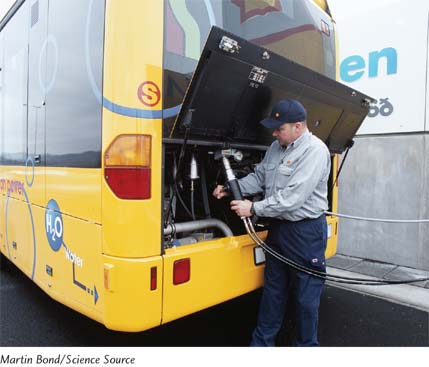working toward  sustainability
sustainability
466
Building an Alternative Energy Society in Iceland
The people of Iceland use more energy per capita than the people of any other nation, including the United States. However, the energy Icelanders use is almost all in the form of local, renewable resources that do not pollute or contribute greenhouse gases to the environment.
This isolated European island nation has had to learn to be self-
In the late nineteenth and early twentieth centuries, Iceland began to look to its own resources for energy. It began by tapping its abundant freshwater resources to generate hydroelectricity, which became the country’s major energy source for residential and industrial use. This transition led to the general electrification and economic modernization of the country and greatly reduced its dependence on imported fossil fuels. Iceland did not stop with hydroelectricity, however, but sought ways to utilize its other major renewable energy source: the thousands of geysers and hot springs on this volcanic island that would provide ready access to geothermal energy.

Geothermal energy is now the primary energy source for home heating in Iceland, and geothermal and hydroelectric resources provide energy for nearly all electricity generation in the country. Even so, the potential of these resources remains relatively underutilized. Iceland has harvested only about 17 percent of its hydroelectric potential, and there is even more potential in its geothermal resources.
Despite its commitment to renewable energy, Iceland is still dependent on imported fossil fuels to run its cars, trucks, buses, and fishing vessels. In a further push for energy independence, Iceland is now developing new technologies that could harness another vast and clean source of energy, hydrogen. In 2000, in partnership with the automobile company DaimlerChrysler, the European energy giant Norsk Hydro, and the oil company Royal Dutch Shell, Iceland embarked on an ambitious project that could wean the country from fossil fuels by 2050. The plan is to use its sustainably generated electricity to split water and obtain hydrogen, then use that hydrogen as fuel.
In April 2003, Iceland opened one of the world’s first filling stations for hydrogen-
Critical Thinking Questions
Can the knowledge and experience gained in Iceland be applied to many other parts of the world? Why or why not?
What is the most up-
to- date information on hydrogen fuel cell use in automobiles in the United States? How many hydrogen fueling stations are there and where are they?
References
Blanchette, S. 2008. A hydrogen economy and its impact on the world as we know it. Energy Policy 36:522–
Maack, M. H., and J. B. Skulason. 2006. Implementing the hydrogen economy. Journal of Cleaner Production 14:52–